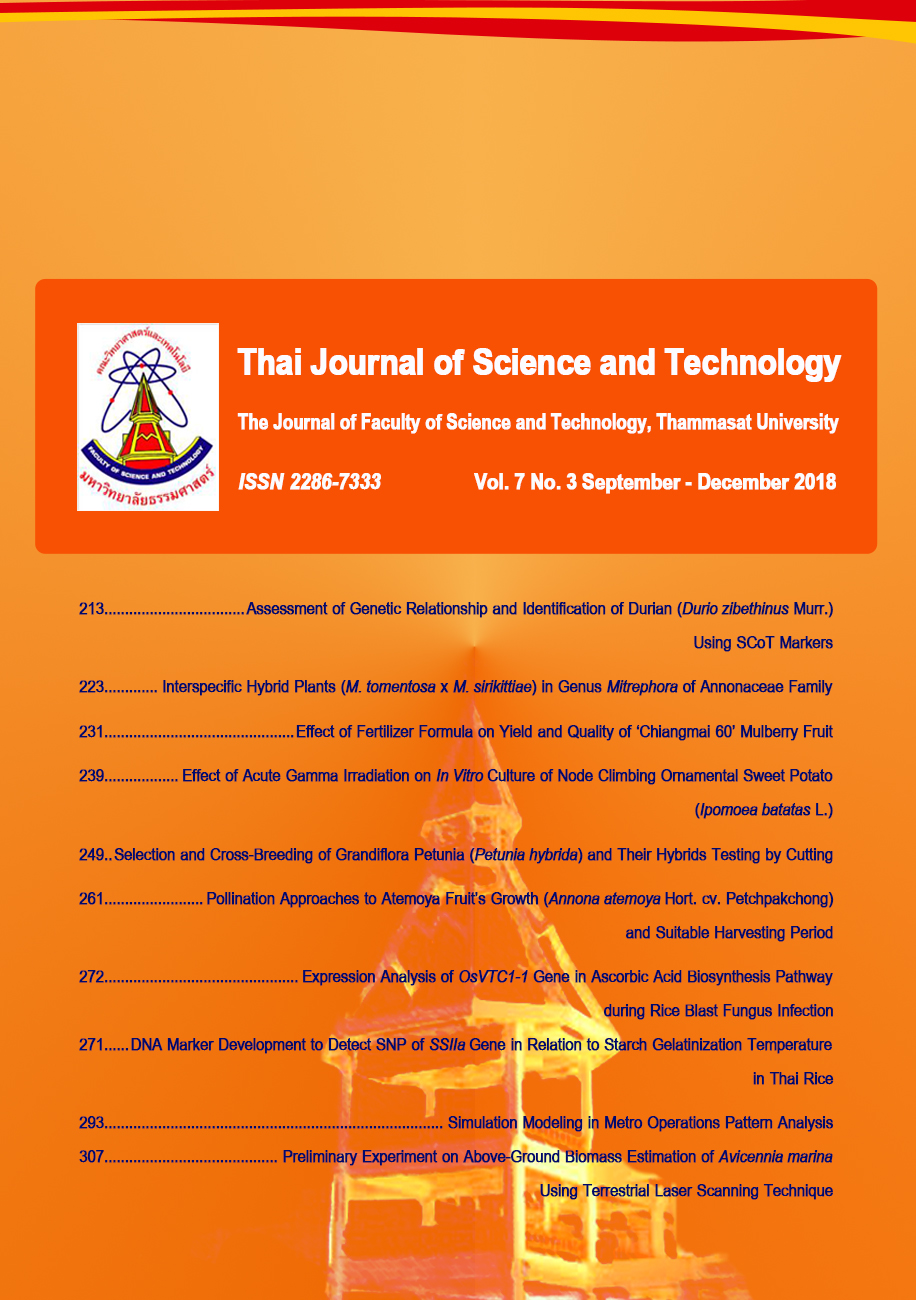การใช้แบบจำลองในการวิเคราะห์รูปแบบการให้บริการเดินรถไฟฟ้าขนส่งมวลชนในเมือง
Main Article Content
Abstract
บทคัดย่อ
ในช่วงที่ผ่านมาระบบขนส่งทางรางในประเทศไทยได้รับการสนับสนุนจากภาครัฐจำนวนมาก เห็นได้จากการพัฒนาโครงการรถไฟฟ้าขนส่งมวลชนต่าง ๆ ในพื้นที่โดยรอบกรุงเทพมหานคร นอกจากนี้เมืองขนาดใหญ่ ไม่ว่าจะเป็นขอนแก่นหรือภูเก็ต ต่างให้ความสนใจในการบูรณาการระบบรถไฟฟ้าเข้ากับแผนพัฒนาเมือง สำหรับระบบรถไฟฟ้านั้นการจัดตารางเดินรถเป็นเรื่องสำคัญที่ส่งผลต่อประสิทธิภาพในการให้บริการ อย่างไรก็ตาม การจัดตารางเดินรถเป็นเรื่องที่ไม่ง่าย เนื่องจากความซับซ้อนของข้อมูลที่เกี่ยวข้อง งานวิจัยนี้มีวัตถุประสงค์เพื่อศึกษาการใช้แบบจำลองในการจัดตารางเดินรถไฟฟ้า โดยมีโครงการรถไฟฟ้ามหานคร สายฉลองรัชธรรม เป็นกรณีศึกษา การศึกษาเริ่มจากการเก็บข้อมูลและทำความเข้าใจรูปแบบการเดินรถ จากนั้นกำหนดสถานการณ์ภายใต้เงื่อนไขการเดินรถตามแผนที่กำหนดไว้รวมถึงสภาวะไม่ปกติร่วมกับการรถไฟฟ้าขนส่งมวลชนแห่งประเทศไทย จากการศึกษาพบว่าการเตรียมข้อมูลและการจัดทำกรอบแนวคิดต่าง ๆ ช่วยให้เห็นถึงปัจจัยสำคัญที่ส่งผลต่อการเดินรถ โดยเฉพาะข้อกำหนดเรื่องเวลาการปล่อยรถและระยะเวลาที่จุดกลับรถ การปรับรูปแบบการเดินรถ โดยไม่พิจารณาปัจจัยดังกล่าวอาจส่งผลให้เกิดความล่าช้าและการเปลี่ยนแปลงจำนวนรถที่ให้บริการ งานวิจัยนี้สามารถประยุกต์ใช้เป็นแนวทางในการจัดตารางเดินรถสำหรับโครงการรถไฟฟ้าอื่น ๆ ในอนาคต
คำสำคัญ : การจำลองสถานการณ์; การจัดตารางการเดินรถไฟฟ้า; แบบจำลองการเดินรถไฟฟ้า
Abstract
Rail transportation has been rapidly developing in recent years in Thailand with a strong encouragement of the government. An outcome of this support is the establishment of plans for many new Metro line projects in Bangkok and beyond its boundaries. Furthermore, agencies of the other large cities in Thailand, such as Khon Kean or Phuket, also show interest in integration of Metro system in their urban development plans. For any rail systems, a train schedule is an important part to effectively manage customer demands and resources. However, a proper train schedule is not easy to plan because of the complexity of required information. The research objective was to use simulation model for train timetabling with a case study of Metropolitan Rapid Transit Chalong Ratchadham Line in Bangkok in order to design a suitable timetable. First, gathering the data and understanding the rail operations took place. Next, setting scenarios together with Mass Rapid Transit Authority of Thailand for the current service as well as a feasibility plan and a degraded plan were designed. The results show that data preparing and conceptual layout can define the important factors in the operations, especially the time of dispatching and the dwell time of a turn back point. Therefore, changing train operations pattern without considering these factors can cause the delay in the network and influence the number of trains in use. Outcomes of this research can act as the guideline for systematic timetabling of the other rail projects planned in the near future.
Keywords: simulation; rail timetabling; rail simulation model
Article Details
บทความที่ได้รับการตีพิมพ์เป็นลิขสิทธิ์ของคณะวิทยาศาสตร์และเทคโนโลยี มหาวิทยาลัยธรรมศาสตร์ ข้อความที่ปรากฏในแต่ละเรื่องของวารสารเล่มนี้เป็นเพียงความเห็นส่วนตัวของผู้เขียน ไม่มีความเกี่ยวข้องกับคณะวิทยาศาสตร์และเทคโนโลยี หรือคณาจารย์ท่านอื่นในมหาวิทยาลัยธรรมศาสตร์ ผู้เขียนต้องยืนยันว่าความรับผิดชอบต่อทุกข้อความที่นำเสนอไว้ในบทความของตน หากมีข้อผิดพลาดหรือความไม่ถูกต้องใด ๆ
References
การรถไฟฟ้าขนส่งมวลชนแห่งประเทศไทย (รฟม.), รถไฟฟ้ามหานคร สายฉลองรัชธรรม, แหล่ง ที่มา : https://www.mrta.co.th/th/project electrictrain/purpleline, 4 สิงหาคม 2560.
นคร จันทศร, 2555, ช่างรถไฟ ความรู้ทั่วไปด้านวิศวกรรมรถไฟ, สำนักงานพัฒนาวิทยาศาสตร์และเทคโนโลยีแห่งชาติ, กรุงเทพฯ.
บริษัท ทางด่วนและรถไฟฟ้ากรุงเทพ จำกัด (BEM), รถไฟฟ้าสายสีม่วง, แหล่งที่มา : https://www.bangkokmetro.co.th/mapPPL.aspx?Menu=183&Lang =Th, 4 สิงหาคม 2560.
ประจวบ กล่อมจิตร และกัญจนา ทองสนิท, 2554, การจำลองสถานการณ์เบื้องต้น, วิศวกรรมสถานแห่งประเทศไทย ในพระบรมราชูปถัมภ์, กรุงเทพฯ.
มานะชัย วัฒนหัตถกรรม, 2556, ระบบควบคุมรถไฟฟ้าและอาณัติสัญญาณเบื้องต้น, โครงการศูนย์นวัตกรรมทางโลจิสติกส์ คณะวิศวกรรมศาสตร์ มหาวิทยาลัยมหิดล, นครปฐม.
วเรศรา วีระวัฒน์, โชคชัย จูฑะโกสิทธิ์กานนท์, อิทธิโชติ จักรไพวงศ์, สมนิดา รัตนาปนะโชติ, ธรรมวฤทธิ์ สิงหวิลัย และภูมินท์ กิระวานิช, 2557, ระบบรางขั้นพื้นฐาน (Fundamentals of rail systems), โครงการศูนย์นวัตกรรมทางโลจิสติกส์ คณะวิศวกรรมศาสตร์ มหาวิทยาลัยมหิดล, นครปฐม.
วิกิพีเดีย, รถไฟฟ้ามหานคร สายฉลองรัชธรรม, แหล่งที่มา : https://th.wikipedia.org/wiki/รถไฟฟ้ามหานคร_สายฉลองรัชธรรม, 4 สิงหาคม 2560.
วิศวกรรมสถานแห่งประเทศไทยในพระบรมราชูปถัมภ์ (วสท.), การพัฒนาระบบราง, แหล่งที่มา : http://eit.or.th, 20 กุมภาพันธ์ 2559.
สำนักงานนโยบายและแผนการขนส่งและจราจร (สนข.), การพัฒนาระบบราง, แหล่งที่มา : http://www.otp.go.th/index.php/component/content/article/71.html, 20 กุมภาพันธ์ 2559.
Cancaa, D., Barrenaa, E. and Algabaa, E., 2014, Design and analysis of demand-adapted railway timetables, J. Adv. Transport. 48: 119-137.
Cordeau, J.F., Toth, P. and Vigo, D., 1998, A survey of optimization models for train outing and scheduling, Transport. Sci. 32: 380-404.
Dicembre, A. and Ricci, S., 2011, Railway traffic on high density urban corridors: Capacity, signalling and timetable, J. Rail Transport Plan. Manag. 1(2): 59-68.
Fang, W., Yang, S. and Yao, X., 2015, A Survey on Problem Models and Solution Approaches to Rescheduling in Railway Networks, Intel. Transport. Syst. IEEE Transact. 99: 1-20.
Hansen, I.A. and Pachl, J., 2008, Railway Timetabling & Operation, Eurailpress, Germany.
Hasannayebi, E., Sajedinejad, A., Mardani, S. and Mohammadi, K.S.A.R.M., 2012, An integrated simulation model and evolutionary algorithm for train timetabling problem with considering train stops for praying, Proceedings of the 2012 Winter Simulation Conference (WSC), Berlin, p. 1-13.
Huerlimann, D. and Nash, A.B., 2017, Open Track Simulation of Railway Networks User Manual, ETH Zurich.
Wen, Z.J., Tin, K.H. and Bao, H.M., 2009, A Study of Heuristic Approach on Station Track Allocation in Mainline Railways, Proceeding of the Fifth International Conference of Natural Computation (ICNC).
Yalçınkaya, Ö. and Bayhan, G.M., 2012, A feasible timetable generator simulation modelling framework for train scheduling problem, Simul. Model. Pract. Theor. 20: 124-141.


